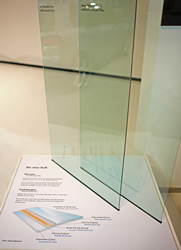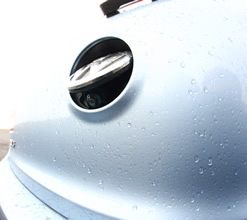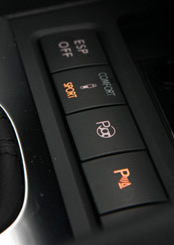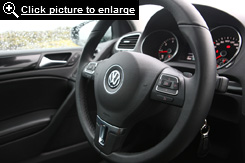Volkswagen Golf Mark 6 TSI and TDI in Iceland Review
16 Oct 2008|42,792 views
So it does seem like an odd place for Volkswagen to stage the launch of the new Golf, considering that the Mark 6 was hastened into production because it is now considerably cheaper to build and assemble, compared to the Mark 5.
But as it turned out, Chief designer Walter De Silva chose the land of fire and ice because of an intricate interplay between light and shadow, cast over the sweeping lines of the Golf. Heritage retention from the first Golfs was also an important consideration in designing the new front grille.
But when we first saw it, we were still disappointed that the final product revealed a less-than-desirable car, compared to the drawing of the Mark 6 concept found here. Taking a look at our pictures, one might even think that the Golf looks rather dull compared to the (again) dramatic backdrop of vast, expansive Icelandic scenery.
Well, that's perfectly understandable. Realistically put, the Golf 6 really is an evolution of its predecessor, rather than a revolution. Like most new models from the German carmaker, the Golf's side profile appears to be beefed up; subtly modernised, and with a touch of smoothness along the rough edges. The exterior panel gaps appear closer, while the oversized rear tail lights resemble the Touareg's.
While you might think that the extra money saved goes into the shareholder's pockets, we think that the bulk of its future, potential savings appear to have gone in the way of pushing the Golf 6 into the class of upmarket A-segment cars. And of course, there's marketing, harping over the upmarket (there's that word again) build quality and the painstaking work done in order to reduce weight, and further refinement in every aspect of this VW.
We weren't convinced™
| |||||
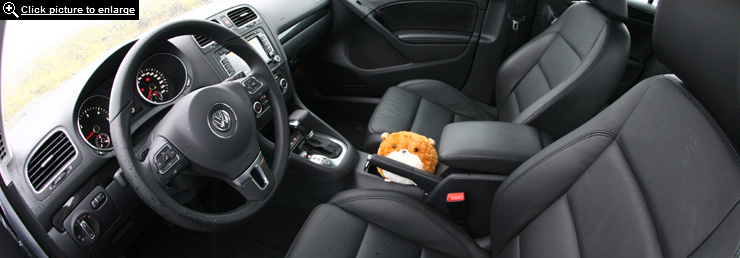 |
Ride and handling impressions
Start the engine. It nudges to life without so much as a distant jerk. That's about as uncomfortable as it gets. Adjustability is a marked improvement over the Golf 5. It was easier to get seated the way we wanted, and in a shorter time too. The steering wheel snapped into position and from the moment we moved off, and it felt more at home in our hands and had noticeably more feedback from the road surface.
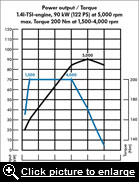 | We'll start with the 1.4-litre turbocharged TSI. Like the current Golf Mark 5 1.4-litre, single turbocharged TSI, the engine generates similar power and torque figures. The differences are of course, how it meters its power out. In the current Mark 5, we mentioned that the 7-speed DSG tends to shift up into the highest possible ratio as soon as possible in an effort to economise on petrol. This happens even when the throttle is deliberately pressed further into the carpet, in effect catching the engine off-guard and out of the power band when overtaking. This does not happen on the Golf 6. Yes, it still shifts early when not in sport mode, but it didn't force the gears up. Instead, it paid more attention to the driver's throttle inputs before deciding when to swap cogs when left in fully automatic mode. | |
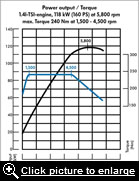 | The next one up would be the 1.4-litre turbocharged and supercharged Golf, with 160 bhp being available at 5,800 rpm and 240 Nm of torque from 1,500-4,500 rpm. This model effectively replaces the current Golf GT. Don't be fooled by the 10-horse deficit, because the 7-speeder more than makes up for it. While we can't do a head-to-head comparison with the current Golf GT, our notoriously accurate butt dynos felt no noticeable loss in acceleration at all speeds. In fact, we dare say that the twin-charged TSI accelerated faster with better-spaced gear ratios. Seventh gear cruises at 80 km/h yielding around 1800 rpm, suggesting good fuel economy figures too. | |
 | Perhaps the most interesting variant we got our hands on was the 2.0-litre TDI turbodiesel. It generates 140 bhp at 4,200rpm and an astounding 320 Nm of torque from 1,750-2,500rpm. That's plenty, considering a diesel engine doesn't need to rev much, and has a 5,000rpm limit. It's impressive. There's enough push to shove you into your seat when you give it the beans from first through third. Even above 100 km/h, it accelerates beyond motorway speed limits with utter ease. And while the Golf is in that heady, three-figured region, it settles into an easy, nonchalant and refined cruise. | |
 | ||
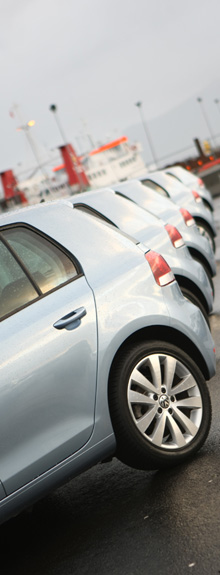 | It was then that we realised how well the sound-deadening efforts have worked. None of us would have known we were piloting a diesel if we didn't step outside the car to listen carefully. As with the other two Golfs, heavy rain pounding on the roof at high motorway speeds was reduced to a mild buzz. Their engines were without a doubt, an uncannily distant travel escort. So there we have it The new Volkswagen Golf doesn't look dramatically different from the car it replaces. My girlfriend would probably have a hard time playing spot-the-difference between the two when placed side-by-side. And if sketches are anything to come by, the Golf could have looked as good as when it was conceptualised on paper. However, if VW had gone in the way of what Honda did to the Civic nearly a decade ago, all of its loyal followers would have deserted the brand for something like a Ford Focus, or even the Audi A3. You see, the people's carmaker have given them a Golf that they have come to know and love. They've opened up unprecedented levels of sophistication which, unlike its launch venue, simply do not match its bread and butter price. After all, buyers of the Golf are the same people who swear by vanilla ice cream, a good bottle of German beer, watching the BBC and their homebrewed espresso piping hot. All of which we had no trouble looking for in Iceland. |
So it does seem like an odd place for Volkswagen to stage the launch of the new Golf, considering that the Mark 6 was hastened into production because it is now considerably cheaper to build and assemble, compared to the Mark 5.
But as it turned out, Chief designer Walter De Silva chose the land of fire and ice because of an intricate interplay between light and shadow, cast over the sweeping lines of the Golf. Heritage retention from the first Golfs was also an important consideration in designing the new front grille.
But when we first saw it, we were still disappointed that the final product revealed a less-than-desirable car, compared to the drawing of the Mark 6 concept found here. Taking a look at our pictures, one might even think that the Golf looks rather dull compared to the (again) dramatic backdrop of vast, expansive Icelandic scenery.
Well, that's perfectly understandable. Realistically put, the Golf 6 really is an evolution of its predecessor, rather than a revolution. Like most new models from the German carmaker, the Golf's side profile appears to be beefed up; subtly modernised, and with a touch of smoothness along the rough edges. The exterior panel gaps appear closer, while the oversized rear tail lights resemble the Touareg's.
While you might think that the extra money saved goes into the shareholder's pockets, we think that the bulk of its future, potential savings appear to have gone in the way of pushing the Golf 6 into the class of upmarket A-segment cars. And of course, there's marketing, harping over the upmarket (there's that word again) build quality and the painstaking work done in order to reduce weight, and further refinement in every aspect of this VW.
We weren't convinced™
| |||||
 |
Ride and handling impressions
Start the engine. It nudges to life without so much as a distant jerk. That's about as uncomfortable as it gets. Adjustability is a marked improvement over the Golf 5. It was easier to get seated the way we wanted, and in a shorter time too. The steering wheel snapped into position and from the moment we moved off, and it felt more at home in our hands and had noticeably more feedback from the road surface.
 |  | We'll start with the 1.4-litre turbocharged TSI. Like the current Golf Mark 5 1.4-litre, single turbocharged TSI, the engine generates similar power and torque figures. The differences are of course, how it meters its power out. In the current Mark 5, we mentioned that the 7-speed DSG tends to shift up into the highest possible ratio as soon as possible in an effort to economise on petrol. This happens even when the throttle is deliberately pressed further into the carpet, in effect catching the engine off-guard and out of the power band when overtaking. This does not happen on the Golf 6. Yes, it still shifts early when not in sport mode, but it didn't force the gears up. Instead, it paid more attention to the driver's throttle inputs before deciding when to swap cogs when left in fully automatic mode. |
 | ||
 |  | The next one up would be the 1.4-litre turbocharged and supercharged Golf, with 160 bhp being available at 5,800 rpm and 240 Nm of torque from 1,500-4,500 rpm. This model effectively replaces the current Golf GT. Don't be fooled by the 10-horse deficit, because the 7-speeder more than makes up for it. While we can't do a head-to-head comparison with the current Golf GT, our notoriously accurate butt dynos felt no noticeable loss in acceleration at all speeds. In fact, we dare say that the twin-charged TSI accelerated faster with better-spaced gear ratios. Seventh gear cruises at 80 km/h yielding around 1800 rpm, suggesting good fuel economy figures too. |
 | ||
 |  | Perhaps the most interesting variant we got our hands on was the 2.0-litre TDI turbodiesel. It generates 140 bhp at 4,200rpm and an astounding 320 Nm of torque from 1,750-2,500rpm. That's plenty, considering a diesel engine doesn't need to rev much, and has a 5,000rpm limit. It's impressive. There's enough push to shove you into your seat when you give it the beans from first through third. Even above 100 km/h, it accelerates beyond motorway speed limits with utter ease. And while the Golf is in that heady, three-figured region, it settles into an easy, nonchalant and refined cruise. |
 | ||
 | ||
 |  | It was then that we realised how well the sound-deadening efforts have worked. None of us would have known we were piloting a diesel if we didn't step outside the car to listen carefully. As with the other two Golfs, heavy rain pounding on the roof at high motorway speeds was reduced to a mild buzz. Their engines were without a doubt, an uncannily distant travel escort. So there we have it The new Volkswagen Golf doesn't look dramatically different from the car it replaces. My girlfriend would probably have a hard time playing spot-the-difference between the two when placed side-by-side. And if sketches are anything to come by, the Golf could have looked as good as when it was conceptualised on paper. However, if VW had gone in the way of what Honda did to the Civic nearly a decade ago, all of its loyal followers would have deserted the brand for something like a Ford Focus, or even the Audi A3. You see, the people's carmaker have given them a Golf that they have come to know and love. They've opened up unprecedented levels of sophistication which, unlike its launch venue, simply do not match its bread and butter price. After all, buyers of the Golf are the same people who swear by vanilla ice cream, a good bottle of German beer, watching the BBC and their homebrewed espresso piping hot. All of which we had no trouble looking for in Iceland. |
Thank You For Your Subscription.

















